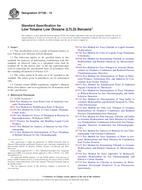We need your consent to use the individual data so that you can see information about your interests, among other things. Click "OK" to give your consent.
ASTM D2157-94(2013)
Standard Test Method for Effect of Air Supply on Smoke Density in Flue Gases from Burning Distillate Fuels
STANDARD published on 1.5.2013
The information about the standard:
Designation standards: ASTM D2157-94(2013)
Note: WITHDRAWN
Publication date standards: 1.5.2013
SKU: NS-19457
The number of pages: 3
Approximate weight : 9 g (0.02 lbs)
Country: American technical standard
Category: Technical standards ASTM
The category - similar standards:
Annotation of standard text ASTM D2157-94(2013) :
Keywords:
heating oil, kerosine, smoke density, ICS Number Code 75.160.20 (Liquid fuels)
Additional information
| Significance and Use | ||
|
5.1 This test method relates efficiency of operation of domestic heating equipment to clean burning. Reducing combustion air in a burner gives more efficient operation. The extent to which combustion air can be reduced is limited by the onset of unacceptable smoke production. By delineating the relation between smoke density and air supply, this test method (together with net stack temperature data) defines the maximum efficiency for a given installation at any acceptable smoke level. 5.2 For certain types of equipment, such as the rotary wall-flame burner, too much excess air will cause smoke as well as too little. For these cases, the point of minimum excess air at the acceptable smoke level indicates the optimum efficiency. 5.3 The operating temperatures of the equipment will affect these test results. The relation of excess air to smoke density is thus susceptible to some change at different points in an operating cycle. In practice, an adequate compromise is possible by operating the burner for 15 min before any readings are recorded and then obtaining the test data within a succeeding 25-min period. 5.4 Under laboratory conditions, CO1.1 This test method covers the evaluation of the performance of distillate fuels from the standpoint of clean, efficient burning. It is intended primarily for use with home heating equipment burning No. 1 or No. 2 fuel oils. It can be used either in the laboratory or in the field to compare fuels using a given heating unit or to compare the performance of heating units using a given fuel. 1.2 The values stated in inch-pound
units are to be regarded as standard. The values given in
parentheses are mathematical conversions to SI units that are
provided for information only and are not considered standard.
1.2.1 Arbitrary and relative units are also used. 1.3 This standard does not purport to address all of the safety concerns, if any, associated with its use. It is the responsibility of the user of this standard to establish appropriate safety and health practices and determine the applicability of regulatory limitations prior to use. |
||
| 2. Referenced Documents | ||
|
Similar standards:
Historical
1.5.2014
Historical
1.11.2012
Historical
15.6.2013
Historical
1.5.2013
Historical
15.1.2012
Historical
15.7.2011
We recommend:
Technical standards updating
Do you want to make sure you use only the valid technical standards?
We can offer you a solution which will provide you a monthly overview concerning the updating of standards which you use.
Would you like to know more? Look at this page.



 ASTM D7170-14
ASTM D7170-14 ASTM D7185-12
ASTM D7185-12 ASTM D7212-13
ASTM D7212-13 ASTM D7215-08(2013)..
ASTM D7215-08(2013).. ASTM D7220-12
ASTM D7220-12 ASTM D7223-11
ASTM D7223-11
 Cookies
Cookies
